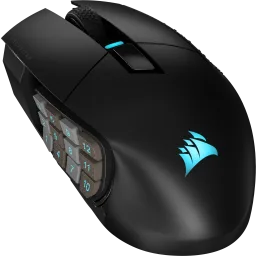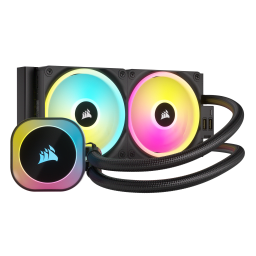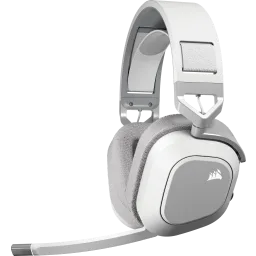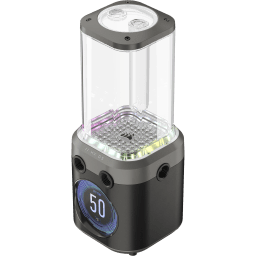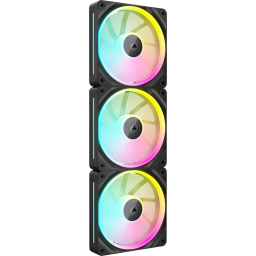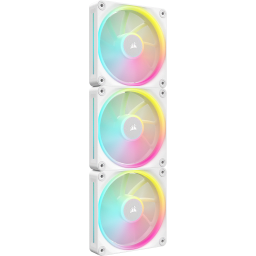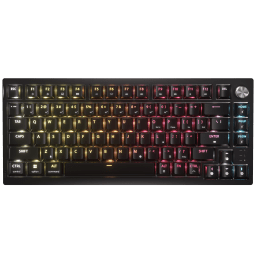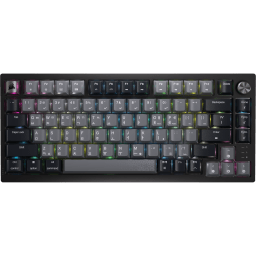iCUE 소프트웨어는 다양한 기능을 제공합니다. 매크로를 만들고, 팬을 제어하고, 시스템 온도를 추적하는 등 다양한 기능을 사용할 수 있습니다.
하지만 어떤 사람들은 그런 것에는 관심이 없습니다. 이들은 마우스, 키보드, 팬, CPU 쿨러, RAM 및 기타 모든 커세어 키트의 조명이 동기화되기를 원합니다. 번거로움 없이 조명을 통해 일관된 설정을 만드는 것 이상을 원하지 않습니다. 이것이 바로 조명 링크 기능의 주요 목적입니다. 그래서 오늘은 이 기능의 위치와 사용 방법을 알려드리겠습니다.
iCUE의 라이팅 링크는 어디에 있나요?
뮤럴(나중에 자세히 설명)과 달리 라이팅 링크는 iCUE의 전면 중앙에 자체 탭이 없습니다. 대신 장치 모듈 중 하나에서 찾아서 적용해야 합니다. 방법은 다음과 같습니다.
- iCUE를 설치하고 최신 버전인지 확인하세요.
- 홈페이지에 표시되는 모듈 중 하나를 클릭합니다(이 예에서는 iCUE LINK H150i RGB 쿨러를 사용하고 있습니다). 그러나 Lighting Link의 핵심은 모든 장치에서 조명을 동기화하는 것이므로 어떤 것을 선택하든 상관없으므로 그중 하나를 선택하기만 하면 됩니다.

- 이제 모듈에서 "조명 레이어 " 섹션의 노란색 버튼을 클릭합니다. 그러면 오른쪽에 "조명 유형" 상자가 열리고 여기에서 조명 링크를 찾을 수 있습니다. 조명 레이어 메뉴에서 아래로 스크롤하여 조명 링크 하위 메뉴를 찾습니다.

- 이러한 옵션 중 하나를 클릭하면 전체 설정이 선택한 모드로 즉시 변경됩니다.

- 조명 유형 메뉴 오른쪽에 또 다른 두 개의 상자가 나타납니다. 첫 번째 상자를 사용하면 조명 링크 효과에서 장치를 추가하거나 제거할 수 있습니다. 두 번째 상자에는 선택한 조명 효과에 따라 몇 가지 옵션이 제공되므로 원하는 대로 조명을 수정할 수 있습니다.

이제 모든 커세어 기어에 완전히 동기화된 새로운 조명 효과를 적용하면 모든 작업이 완료됩니다.
iCUE를 열 때까지 라이팅 링크가 작동하지 않습니다. 왜 그럴까요?
장치 메모리 모드와 달리 조명 링크는 조명 프리셋을 물리적 장치 자체에 저장하지 않습니다. 이는 원하는 동기화를 달성하기 위해 이러한 장치가 서로 통신할 수 있도록 iCUE가 필요하기 때문입니다.
이 문제는 PC를 시작할 때 iCUE가 자동으로 실행되도록 설정하면 해결할 수 있습니다. 이 기능을 활성화하면 Windows가 로드되는 즉시 iCUE가 백그라운드에서 열리고 라이팅 링크가 시작됩니다. 오른쪽 상단의 톱니바퀴 아이콘으로 iCUE 설정 메뉴를 열고 이 기능을 활성화합니다.

iCUE 뮤럴과 라이팅 링크: 차이점은 무엇인가요?
이제 여러분 중 일부는 이것이 벽화 기능과 매우 비슷하게 들린다는 것을 알아차릴 수 있습니다.
기본적으로 iCUE Murals는 전체 설정에서 동기화된 RGB 조명을 보다 간단하게 얻을 수 있는 방법이며, 조명을 동기화하여 모니터의 내용을 실시간으로 반영하고 반응할 수도 있습니다. 이것이 바로 뮤럴의 주요 판매 포인트입니다. ( Govee 및 Philips Hue의 조명 스트립과 같은 호환 가능한 타사 제품도 사용할 수 있습니다.)
그러나 이 기능이 중요하지 않다면 적용하고 사용자 지정할 수 있는 효과가 더 넓은 라이팅 링크가 더 나은 솔루션일 수 있습니다.
기사 내 제품


